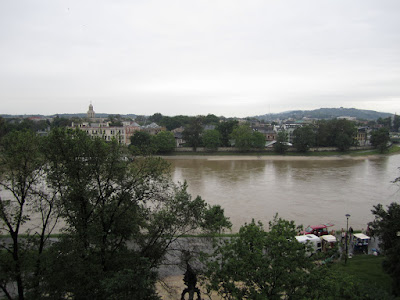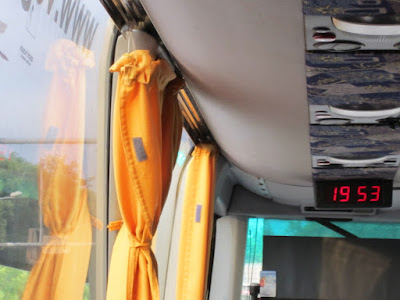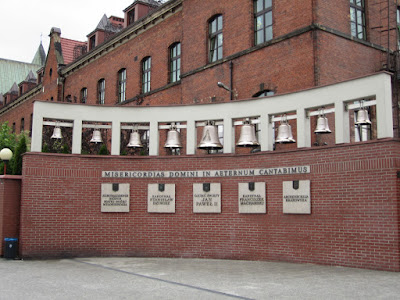Among the countries we visited in Eastern Europe, Poland was the least place I’m familiar with. Other than Schindler’s List, the Auschwitz concentration camp and being the birthplace of Pope John Paul 2, I didn’t have any other idea about Poland.
I remember several years ago, I had a Polish colleague named Sebastian. A Colombian colleague and I asked him what is there to see in Poland and he said nothing much. He didn't give us any reason to visit Poland! Haha...
But Poland turned out to be a big surprise for me. To start with, the weather was perfect – though cold, around 12 degrees Celsius, it was sunny. It made up for the bad weather we experienced in Prague. Plus, I learned a lot of new things.
Here are some snippets from our trip to Poland:
I remember several years ago, I had a Polish colleague named Sebastian. A Colombian colleague and I asked him what is there to see in Poland and he said nothing much. He didn't give us any reason to visit Poland! Haha...
But Poland turned out to be a big surprise for me. To start with, the weather was perfect – though cold, around 12 degrees Celsius, it was sunny. It made up for the bad weather we experienced in Prague. Plus, I learned a lot of new things.
Here are some snippets from our trip to Poland:
Krakow or Cracow (pronounced as Kra-kov) is the place where the tragedy of the Jewish ghetto in Poland happened (as depicted in the movie Schindler’s List).
We passed by the Jewish ghetto, as well as Oskar Schindler’s factories.
It was mostly gray and depressing especially once you start imagining what transpired here between 1941-43. I watched Schindler’s List a long time ago but I can still clearly remember some tragic images until now.
Our travel operator said that normally, the Auschwitz concentration camp is included in the itinerary but, she says, a lot of tourists get depressed after visiting the place and so they’ve removed it from the list.
Still in Krakow, we visited the Wawel Cathedral (pronounced as Va-Vel). This is where kings are crowned, and the royalty and heroes buried. For 20 years, Pope John Paul 2 also celebrated mass here (before he became the Pope). Beautiful cathedral (sorry no pic-taking inside).
BTW, upon entering the Wawel cathedral, don’t forget to look up. Bones of a whale, a mammoth and a rhino hang at the left side of the entrance.
 |
| Sculpture of Pope JP2 at the Krakow Cathedral |
We also walked towards Vistula River to take a peek at the Wawel dragon, a famous dragon in Polish folklore.
 |
| Vistula River - you can spot the the dragon at the bottom center of the photo. |
 |
| Wawel Castle |
On our way to the Main Market Square, we passed by the university where Copernicus and Pope JP2 once studied. Here’s the photo but too bad, I couldn’t remember the name of the university! Haha…
We also passed by 2 buildings where Pope JP2 once lived. This is where Pope JP2 lived when he was an archbishop.
The is where Pope JP2 lived as a bishop and today, it's now a museum.
 |
| Beautiful sculpture inside the Bishop's Palace |
The tour guide also said that the pope used to walk from these homes to the cathedral. Wow, it sure felt so surreal to be walking in the same roads where Pope JP2 once walked!:)
Across the bishop’s palace stands the building where Copernicus once lived. It is now Hotel Copernicus.
We spent most of the time in the Main Market Square just walking around and yep, I had time to enjoy some chocolate gelato. Yum-yum.
Within the Market Square, you'll see St Mary’s Basilica.
If you notice, the towers of the church are uneven. According to a legend, the 2 towers were built by 2 brothers. The less talented brother killed the more gifted one, since he was afraid of competition. The tower whose construction was commenced by the murdered brother was never completed. Today, it is a bell tower.
Here are some photos I took at the Shrine of the Divine Mercy -
One night in Krakow, we had dinner in a restaurant called Bohema. They served pork schnitzel. Actually, in most of the restaurants we went to in Eastern Europe, most of them served schnitzel. :)
We enjoyed an evening of folk songs and dances from Polish performers. Ok, at one point, I was invited by one of the Polish performers to dance. There was a lot of turning – I got dizzy! Wahaha…
While in Krakow, we also passed by this interesting house – it was upside down! I didn’t have the chance though to ask the tour guide what it was.
There's also this chapel which is shaped like a ship -
Outside Krakow, we also visited 2 other places. The Wieliczka Salt Mine, a mining facility that started operations since the Middle Ages. It’s a UNESCO World Heritage Site and is visited by 1 million people annually.
 |
| Entrance to the Wieliczka Salt Mine |
The Wieliczka Salt Mine is a complex of underground excavations consisting of 3,000 chambers of 300 kms in length and up to 327 meters deep! I was able to take photos inside by paying 20 zloty (the Polish currency).
At 101 meters down the chambers, we reached an underground Chapel of St Kinga which contains salt sculptures and bas reliefs and beautiful chandeliers – yes made of salt too! Check out these beautiful photos -
 |
| Chapel of St Kinga |
Our last stop in Poland was in a place called Jasna Gora – home of the Black Madonna or Our Lady of Czestochowa. Again, since I wasn’t able to research anything for this trip, I didn’t have any idea on this place. When we got there, I was surprised by the busloads of people visiting the place - at par with what I saw in Lourdes, France and Fatima, Portugal 3 years ago. This must be a really special place.
Also, spotted these little angels who are about to have their first Holy Communion. :)
If you take a close look at the painting, you will also notice scars on the face of the Lady. There’s also a legend concerning these two scars on the Black Madonna’s right cheek. It is believed that Hussites stormed the monastery in 1430, and stole items including the icon. When they tried to leave, their horses refused to move. They threw the portrait down to the ground and one of the plunderers drew his sword upon the image and inflicted 2 deep strikes. When the robber tried to strike it for the 3rd time, he fell to the ground and squirmed in agony and died. Despite past attempts to repair the scars, painters had difficulty in covering them up as they found out that the painting was painted with tempera infused with diluted wax.
 |
| Crutches left by pilgrims who experienced miracles. |
While at Jasna Gora, we were so lucky to have been able to hear mass at the restricted area reserved for the royalty, bishops and even the pope (thanks to our Polish priest friend who was able to secure us the seats!). I was seated in second row. Yay!
We were also so fortunate to have witnessed the unveiling of the Black Madonna where exactly at 630am on a Sunday, live trumpets would play and a silver cover would slowly lift to reveal the Black Madonna. A real goosebump-inducing experience.
JP2 has celebrated masses in the same Church and as a university student, he and his classmates went to an annual pilgrimage to Jasna Gora. And guess what? During the Nazi occupation in Poland, pilgrimage was banned. But for (then) teenager Karol Wojtyla, so as not to break their annual pilgrimage tradition, sneaked into the sanctuary secretly with two other friends where at that time, Czestochowa was surrounded by Hitler's troops!
 |
| Jasna Gora from a distance |
*************************
Some more useful tips when visiting Poland:
- Local currency: zloty (but some establishments also accept euros)
- Electrical Plug: 2 pin (round type)
- Cost of meals: 10 euros in fastfood centers and about 30 euros in restaurants.
- Cost of bottled water: 1.50 to 3 euros for 500ml when you buy in vending machines and restaurants. But it you buy in convenience stores or grocery stores, 1 liter only costs 1 euro. Also carbonated water is very common so just tell the counter if you want water “with gas” or “no gas”.
- Toilets are called WC (Water closet).
Flight tips:
- If you have interconnecting flights with different airlines, make sure to tell the check-in counter in Manila to check-through your luggage to your final destination.
- Luggage weight allowance is only up to 20 kilos for check-in and up to 7 kilos for handcarry (translation - very minimal shopping since a medium-sized luggage with clothes already weigh about 18 kilos).















































